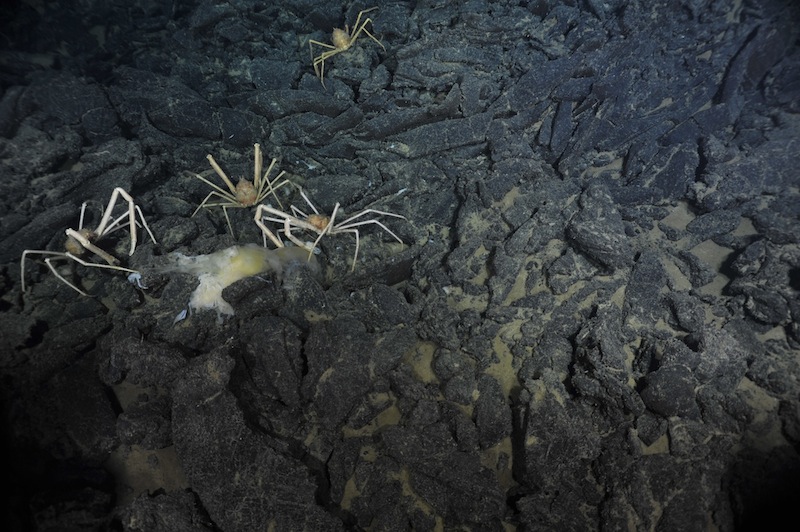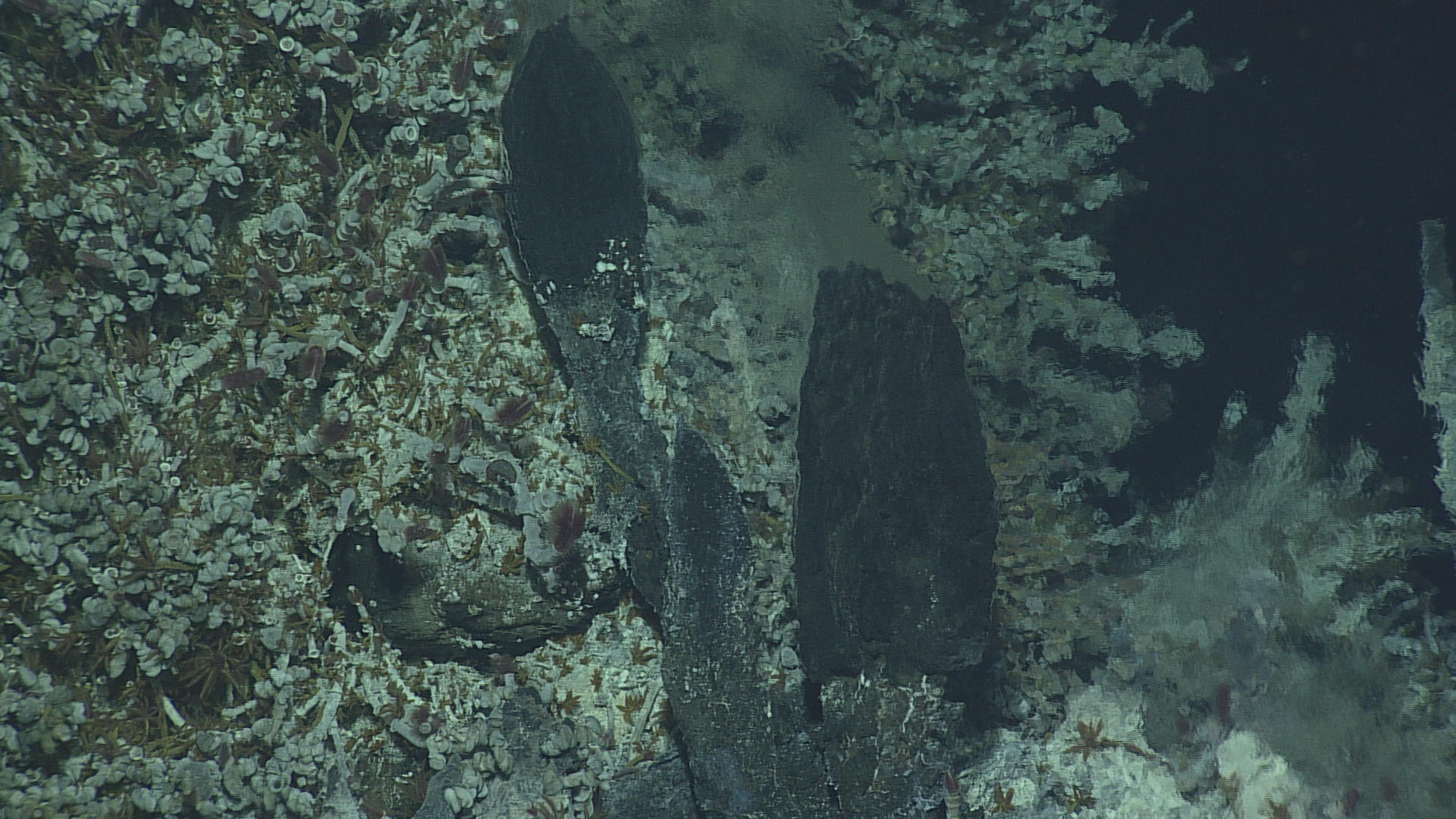Image Archive





























Part of the work required to properly install a seismometer on the seafloor is to ensure that the instrument is level. The yellow disk, shown here, is placed on the seismometer by ROPOS. The legs of the seismometer platform are then adjusted until a level reading is achieved. Credit: UW/NSF-OOI/CSSF; ROPOS, Dive 1617, V14. Credit: NSF-OOI/UW/CSSF

visions_project_prototype J.Ryan Rembert

The summit of the actively venting chimney Inferno in 2013, located in the ASHES hydrothermal field at the summit of Axial Seamount. Credit: UW/NSF-OOI/CSSF; V13. Photo credit: NSF-OOI/UW/CSSF

Crabs eating. VISIONS '13, LEG 3 Photo credit: NSF-OOI/UW/CSSF

Deployment of short-period seismometers on the seafloor requires special consideration in terms of the sensors being level. Here, a special platform hosting the seismometer is being leveled by ROPOS through turning of adjustment bolts on the legs. These instruments will provide important real-time data on seismic activity inside the volcano, and associated with microfracturing events around the plumbing system for hydrothermal vents. VISIONS 13, Dive 1617 Photo credit: NSF-OOI/UW/CSSF

A small Flapjack octopus sits atop a lobate flow at the summit of Axial Seamount - water depth ~ 1500 m (nearly 5000 feet beneath the surface). Credit: UW/OOI-NSF/CSSF, V13.

Kink in ROPOS cable

ROPOS termination box. The fiber optical connections are in front with the BNC like connectors.

First earthquake data from Eastern Caldera subnet. Seen here are two sets of patterns, three panels from each seismometer. VISIONS '13, Leg 3.

Many of the collapse areas have lava pillars that support remnants of the roof that originally covered a lava pond. Credit: UW/NSF-OOI/CSSF; ROPOS Dive R1608; V13.

A cable that will link an instrument to a Secondary Node is buoyant enough so that it easily spans across a large collapse area without danger of abrasion. (VISIONS '13 Dive R-1611) Photo credit: OOI-NSF/UW/CSSF

The testing box on ROPOS was used to plug into a 4356 m (14291 ft!) long extension cable (RS03W7) that starts at Primary Node 3B on the northern side of the caldera, runs clear across the caldera, and ends just west of the black smokers in a zone of safety. It will provide power and communication to two short-period seismometers and a three dimensional temperature array deployed in a diffuse flow site at the base of the chimney called Mushroom. VISIONS '13, Leg 3

This high resolution bathymetric map of the ASHES hydrothermal field shows the location of small, ~ 4 m tall, actively venting sulfide structures. The field is located near the steep western caldera wall. The field is likely fed by fluids circulating up along faults associated with this wall.

A purple-hued hagfish weaves its way through the rugged limestone rock at the Pinnacle at South Hydrate. A pink octocoral and orange squat lobster complete the trio. Credit: UW/NSF-OOI/CSSF; ROPOS Dive R1606

ROV ROPOS with MJ03E. VISIONS '13, Leg 3

Graneledone Octopus on lava dlows at the summit of Axial Seamount. Credit: UW/OOI-NSF/CSSF, ROPOS Dive R1617, V13.

A small flapjack octopus (one of the species of the genus Opisthoteuthis) doesn't seem to mind being on camera. Credit: UW/OOI-NSF/CSSF, ROPOS Dive R1608, V13.

A young smoker near the base of the suflide edifice called 'Mushroom' emits particle-poor, shimmering water at temperatures >100oC. Tube worms, palm worms and limpets bathe in diffusely flowing fluids that vent out of the porous chimney walls and mix with the surrounding, nearly freezing seawater. A high definition camera will be installed at this site providing real-time live imagery in 2014. (VISIONS '13 Dive R-1614) Photo credit: OOI-NSF/UW/CSSF

Cooling lava takes on different shapes, depending on the temperature and vigor of the flow. Here, lava lobes, sheet flow and jumbled flow types fill the frame near to the Ashes vent site on Axial. (VISIONS '13 Dive R-1613) Photo credit: OOI-NSF/UW/CSSF

The seafloor records where a small lava river once flowed. The "banks" are pieces of the solidified lava that were shoved and broken by the swifter, central stream. (VISIONS '13 Dive R-1613) Photo credit: OOI-NSF/UW/CSSF

Flattened oil-filled hose on the horn of the ROV ROPOS Remotely Operated Cable Laying System (ROCLS), VISIONS '13 Dive 1610 Photo credit: OOI-NSF/UW/CSSF

This sulfide chimney, known as Mushroom, rises ~ 4 m (12 ft) above the seafloor. It is located in the ASHES Vent Field and will be the site for deployment of a cabled high definition video camera in 2014 and three-dimensional temperature array, as well as an uncabled vent fluid sampler. Credit: OOI-NSF/UW/CSSF; ROPOS Dive R1614; V13.

Octopus on a lava flow in the caldera of Axial Volcano at a depth of ~ 1500 m (nearly 5000 ft beneath the oceans surface). Credit; UW/NSF-OOI/CSSF; V13.

Close up of a soft coral at the southern end of an ~ 60 m tall carbonate Pinnacle at Southern Hydrate Ridge.

This orange, secondary cable was laid about one week ago by ROPOS. The image, taken during the cable inspection portion of Dive 1608, shows the cable on top of pillow basalts on the seafloor at Axial Volcano. Photo credit: OOI-NSF/UW/CSSF

The bottom pressure and tilt instrument (BOPT), designed by Bill Chadwick of Oregon State University, being deployed onto the seafloor at Axial Seamount by ROPOS as part of the VISIONS'13 expedition. Credit: UW/OOI-NSF/CSSF; V13.

This octopus, nicknamed the Flapjack Octopus, on pillow basalts at the summit of Axial's Eastern caldera. Credit: UW/OOI-NSF/CSSF, ROPOS Dive R1608, V13.

One of ROPOS’ “claws” that can be manipulated from the ship to do many tasks on the infrastructure deployed to the seafloor. Photo by Montgomery Taylor
- Anemone
- Animal
- Arthropod
- ASHES
- Axial
- Axial Base
- Axial Biology
- Axial Caldera
- Bacteria
- Basalt Lava
- BEP
- Biofouling
- biolgoy
- Biology
- Camds
- Camera
- Camhd
- Central Caldera
- Ciliates
- Cnidaria
- Coastal Biology
- Crab
- Deep Profiler Mooring
- Dive Highlights
- Eastern Caldera
- Echinoderms
- Endurance Array
- Engineering Team
- ENLIGHTEN 10
- Exploratorium
- Fish
- Geology
- HD Camera
- HPIES
- Hydrate Ridge
- Hydrates
- Hydrophone
- Hydrothermal Vents
- Illustration
- Inshore 80 Meters
- Instrument
- International District
- J-BOX
- Jason
- Jellyfish
- Junction Box
- K12
- Lava
- Mollusk
- Moorings
- Nodes
- Nudibranch
- Octopus
- OOI
- Oregon Offshore
- Oregon Offshore 600 m
- Oregon Shelf
- Oregon Slope Base
- People
- PN1B
- PN1D
- Polychaetes
- PPSDN
- Primary Node
- RASFL
- ROCLS
- ROPOS
- ROPOS Dives
- ROV Team
- RV Revelle
- RV Sikuliaq
- RV Thompson
- Salp
- Sample
- SC13
- Science Team
- Sea Cucumber
- Sea Star
- Sea Urchin
- Seafloor
- Seismometer
- Sensors
- Shallow Profiler Mooring
- Shark
- Shipboard
- Shore Station
- Slope Base
- Smoker
- Soft Coral
- Southern Hydrate Ridge
- Sponge
- Squid
- Students
- Students & Guest Participants
- Tmpsf
- Tubeworms
- VISIONS 11 Leg 1
- VISIONS 11 Leg 2
- VISIONS 11 Viewers
- VISIONS 13
- VISIONS 14
- VISIONS 15
- VISIONS 16
- VISIONS 17
- VISIONS 18
- VISIONS 20
- VISIONS 22
- VISIONS 23
- Visualization
